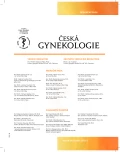Bisphenols in the pathology of reproduction
Authors:
M. Ješeta 1; T. Crha 2; J. Žáková 1; P. Ventruba 1
Authors‘ workplace:
Gynekologicko-porodnická klinika LF MU a FN, Brno, přednosta prof. MUDr. P. Ventruba, DrSc., MBA
1; Lékařská fakulta Masarykovy Univerzity, Brno
2
Published in:
Ceska Gynekol 2019; 84(2): 161-165
Category:
Overview
Objective: Bisphenols are one of the most widespread endocrine disruptors that the population of west world countries is exposed to. Objective of this study is to summarize information about influence of bisphenols on reproduction health.
Design: Review article,
Setting: Department of Obstetrics and Gynecology, Faculty of Medicine, Masaryk University and University Hospital Brno.
Methods: PubMed was searched for articles in English indexed bisphenol and reproduction up to October 2018.
Results: Increased levels of bisphenol A and S have been proven in body fluids and tissues. Bisphenol molecules have effect similar to estrogens therefore they influence hormonal regulation and activity of estrogen receptors. Their negative influence on oocyte maturation, spermatogenesis and development of reproductive system has been shown. Bisphenol S, which has replaced bisphenol A, has comparable negative effects on reproduction.
Conclusion: Bisphenols are widespread endocrine disruptors that could cause severe fertility disorders of men and women.
Keywords:
bisphenol – reproduction – endocrine disruptor – oocyte – spermatozoa
Sources
1. Bushnik, T., Haines, D., Levallois, P., et al. Lead and bisphenol A concentrations in the Canadian population. Health Reports, 2010, 21, p. 7–18.
2. Caserta, D., Maranghi, L., Mantovani, A., et al. Impact of endocrine disruptor chemicals in gynaecology. Hum Reprod Update, 2008, 14, p. 59–72.
3. Caserta, D., Mantovani, A., Marci, R., et al. Environment and women‘s reproductive health. Hum Reprod Update, 2011, 17(3), p. 418–433.
4. Diamanti-Kandarakis, E., Bourguignon, JP., Giudice, LC., et al. Endocrine disrupting chemicals: an Endocrine Society scientific statement. Endocr Rev, 2009, 30, p. 293–342.
5. Ehrlich, S., Williams PL., Missmer SA., et at. Urinary bisphenol A concentrations and early reproductive health outcomes among women undergoing IVF. Hum Reprod, 2012, 27(3), p. 3583–3592.
6. Eladak, S., Grisin, T., Moison, D., et al. A new chapter in the bisphenol A story: bisphenol S and bisphenol F are not safe alternatives to this compound. Fertil Steril, 2015, 103(1), p. 11–21.
7. Fujimoto, VY., Kim, D., vom Saal, FS., et al. Serum unconjugated bisphenol A concentrations in women may adversely influence oocyte quality during in vitro fertilization. Fertil Steril, 2011, 95, p. 1816–1819.
8. Ikezuki, Y., Tsutsumi, O., Takai, Y., et al. Determination of bisphenol A concentrations in human biological fluids reveals significant early prenatal exposure. Hum Reprod, 2002, 17, p. 2839–2841.
9. Jirsová, S. Vliv polychlorovaných bifenylů a organochlorovaných pesticidů na lidskou reprodukci. Čes Gynek, 2018, 83(4), s. 380–384.
10. Kalb, AC., Kalb, AL., Cardoso, TF., et al. maternal transfer of bisphenol a during nursing causes sperm impairment in male offspring. Arch EnvironmentContamination Toxicol, 2016, 70, p. 793–801.
11. Khan, D., Ahmed SA. Epigenetic regulation of non-lymphoid cells by Bisphenol-A, a model endocrine disrupter: potential implications for immunoregulation. Frontiers in Endocrinology, 2015, 6, p. 91.
12. Lazúrová, Z., Lazúrová, I. Environmentálny estrogén bisfenol A a jeho účinky na organizmus člověka. Vnitř lék, 2013, 59(5), p. 466–471.
13. Liao, C., Liu, F., Kannan, K. Bisphenol S, a new bisphenol analogue, in paper products and currency bills and its association with bisphenol A residues. Environment Sci Technol, 2012, 46, p. 6515–6522.
14. Machtinger, R., Combelles, MHC., Missmer, AS., et al. Bisphenol-A and human oocyte maturation in vitro. Hum Reprod, 2013, 28(10), p. 2735–2745.
15. Mráz, M., Svačina, Š., Kotrlíková, E., et al. Potenciální zdroje ftalátů a bisfenolu A a jejich význam u metabolických onemocnění. Čas Lék čes, 2016, 155, p. 11–15.
16. Nakagawa, Y., Tayama, S. Metabolism and cytotoxicity of bisphenol A and other bisphenols in isolated rat hepatocytes. Arch Toxicol, 2002, 74, p. 99–105.
17. Nevoral, J., Kolinko, Y., Moravec, J., et al. Long-term exposure to very low doses of bisphenol S affects female reproduction. Reproduction, 2018, 156(1), p. 47–57.
18. Skakkebaek, N., Rajpert-De Meyts, E., Buck Louis, GM., et al. Male reproductive disorders and fertility trends: influences of enviroment and genetic susceptibility. Physiol Rev, 2016, 96, p. 55–97.
19. Trapphoff, T., Heiligentag, M., Hajj, NE., et al. Chronic exposure to a low concentration of bisphenol A during follicle culture affects the epigenetic status of germinal vesicles and metaphase II oocytes. Fertil Steril, 2013, 100, p. 1758–1767.
20. Ventruba, P., Žáková, J., Trávník, P., et al. Aktuální otázky asistované reprodukce v České republice. Čes Gynek, 2013, 78(4), s. 392–398.
21. Vitku, J., Sosvorova, L., Chlupacova, T., et al. Differences in bisphenol A and estrogen levels in the plasma and seminal plasma of men with different degrees of infertility. Physiol Res, 2015, 64, p. 303–311.
22. Žalmanová, T., Hošková, K., Nevoral, J., et al. Bisphenol S instead of bisphenol A: a story of reproductive disruption by regretable substitution – a review. Czech J Anim Sci, 2016, 61(10), p. 433–449.
23. Žalmanová, T., Hošková, K., Nevoral, J., et al. Bisphenol S negatively affects the meotic maturation of pig oocytes. Scientific Reports, 2017, 7(1), p. 485.
Labels
Paediatric gynaecology Gynaecology and obstetrics Reproduction medicineArticle was published in
Czech Gynaecology

2019 Issue 2
Most read in this issue
- Uterine rupture during pregnancy and delivery: risk factors, symptoms and maternal and neonatal outcomes – restrospective cohort
- Sacrococcygeal teratoma
- Operative vaginal deliveries and their impact on maternal and neonatal outcomes – prospective analysis
- Latest findings on the placenta from the point of view of immunology, tolerance and mesenchymal stem cells
